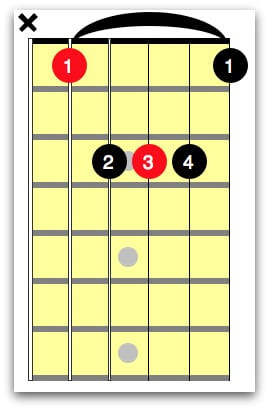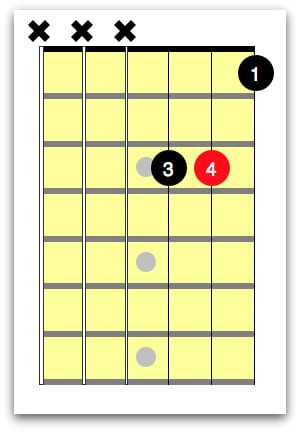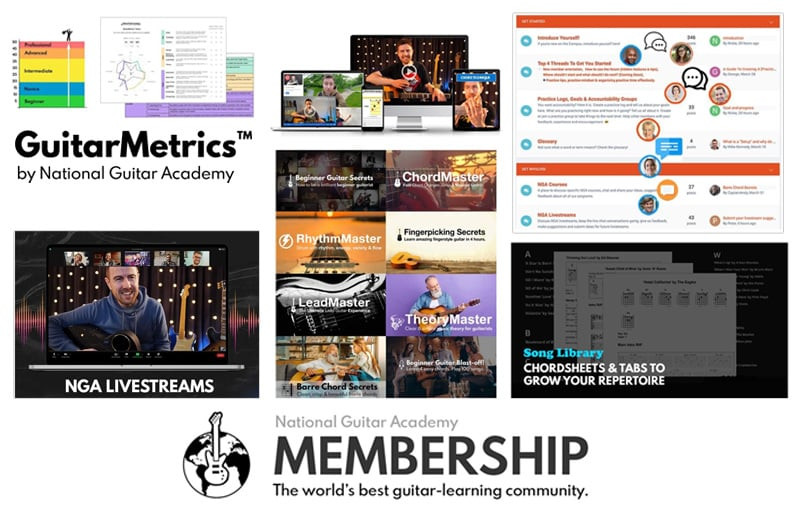Learning guitar chords can be an exciting journey, and mastering chords like the A# (A sharp) is a significant step forward. If you’re looking to add this versatile chord to your repertoire, you’ve come to the right place. This guide will break down the A# guitar chord into easy-to-understand shapes and provide expert tips to help you play it smoothly and confidently.
In this lesson, you’ll discover:
- Multiple ways to play the A# guitar chord, including beginner-friendly versions.
- Essential techniques and tips to enhance your guitar practice and chord transitions.
- The secret to memorizing guitar chords quickly and effectively.
Let’s dive in and explore the world of the A# guitar chord!
What is an A# Guitar Chord?
Before we get into the shapes, let’s clarify what we mean by an “A# guitar chord”. In music theory, if a chord name doesn’t specify “minor,” it’s generally understood to be a major chord. Therefore, when you see “A# chord,” it typically refers to an “A# major chord.”
Think of it this way: A# major is different from A# minor, just like C major is different from C minor. We’ll be focusing on the A# major chord in this lesson.
A# Guitar Chord (E Shape Barre Chord)
One common way to play the A# guitar chord is using the “E shape” barre chord. This shape is called “E shape” because it’s based on the familiar open E major chord shape, but moved up the fretboard and barred.
New to the E chord? Check out our guide on easy ways to play the E chord on guitar to get comfortable with the foundation of this barre chord shape.
Here’s how to form the A# guitar chord using the E shape barre:
- Barre your first finger across all six strings at the 6th fret. Ensure you’re applying enough pressure for all strings to ring clearly.
- Place your third finger on the 8th fret of the A string (5th string).
- Place your fourth finger on the 8th fret of the D string (4th string).
- Place your second finger on the 7th fret of the G string (3rd string).
- Strum all six strings.
Alt text: Diagram showing the A sharp guitar chord in the E shape barre form, with finger positions clearly marked on the 6th, 7th, and 8th frets.
Barre chords can be challenging for beginners as they require finger strength and coordination. Don’t get discouraged if it doesn’t sound perfect right away. Consistent practice is key.
If you’re struggling with barre chords, consider watching tutorials specifically focused on barre chord techniques. These resources can provide valuable tips on finger placement and pressure to make barre chords easier to play.
A# Guitar Chord (A Shape Barre Chord)
Another popular way to play the A# chord is using the “A shape” barre chord. Just like the E shape, this version is derived from the open A major chord shape, shifted up the neck and barred.
Need a refresher on the open A chord? Review our lesson on easy ways to play the A chord on guitar to understand the foundation of this barre chord.
Here’s how to play the A# guitar chord as an A shape barre chord:
- Barre your first finger across the 1st fret from the A string (5th string) to the high E string (1st string). Make sure to press down firmly so all strings ring out clearly when strummed.
- Place your second finger on the 3rd fret of the D string (4th string).
- Place your third finger on the 3rd fret of the G string (3rd string).
- Place your fourth finger on the 3rd fret of the B string (2nd string).
- Strum from the A string (5th string) downwards. Avoid strumming the low E string in this voicing for a cleaner sound.
 A sharp guitar chord A shape barre
A sharp guitar chord A shape barre
Alt text: Image illustrating the A sharp guitar chord in the A shape barre form, showing finger positions on the 1st and 3rd frets, strumming from the A string.
This A shape barre chord is slightly higher in pitch than the E shape barre chord and offers a different tonal color. Experiment with both shapes to see which one suits your musical context best.
Easy Versions of the A# Guitar Chord
For beginners, barre chords can be a hurdle. Thankfully, there are simplified versions of the A# chord that are much easier to play and still sound great, especially in simpler songs or when you need to quickly switch to this chord. Let’s explore three easy A# chord variations.
A# Guitar Chord Version 1 (Two-Finger Version)
This is perhaps the easiest A# chord variation, requiring only two fingers. It’s perfect for beginners getting acquainted with the chord.
To play this simplified A# chord:
- Fret the 1st fret of the low E string (6th string) with your first finger.
- Fret the 1st fret of the A string (5th string) with your second finger.
- Strum only the E, A, and D strings (6th, 5th, and 4th strings). Avoid strumming the G, B, and high E strings.
This version provides the essence of the A# chord and is excellent for practicing chord changes and basic strumming patterns.
Struggling with selective strumming? Learn how to improve your accuracy and isolate strings with our guide on how to skip strings while strumming.
A# Guitar Chord Version 2 (Three-Finger Version)
This version adds a finger but remains beginner-friendly, offering a fuller sound than the two-finger version.
To play this three-finger A# chord:
- Fret the 1st fret of the low E string (6th string) with your first finger.
- Fret the 3rd fret of the G string (3rd string) with your third finger.
- Fret the 3rd fret of the B string (2nd string) with your fourth finger. (Note: In the original article, it mentions 5th string for B string, this should be 2nd string).
- Strum from the G string (3rd string) downwards. Avoid strumming the D, A, and low E strings for this voicing.
 A sharp guitar chord 3 finger version
A sharp guitar chord 3 finger version
Alt text: Image showing the 3-finger version of the A sharp guitar chord, highlighting finger placement on the 1st and 3rd frets, strumming from the G string.
This voicing is richer than the two-finger version and is a great stepping stone to playing full barre chords.
A# Guitar Chord Version 3 (Movable A Shape Version)
If you already know the open A major chord, this version is incredibly intuitive. It’s essentially the open A chord shape moved up the fretboard.
To play this movable A shape A# chord:
- Form the open A major chord shape but place your index finger on the 3rd fret instead of the open strings.
- Place your second finger on the 3rd fret of the D string (4th string).
- Place your third finger on the 3rd fret of the G string (3rd string).
- Place your fourth finger on the 3rd fret of the B string (2nd string).
- Strum from the D string (4th string) downwards. Avoid strumming the A and low E strings.
This version maintains the familiar A chord shape and simply transposes it to create the A# chord. It’s a great way to understand how chord shapes can be moved around the fretboard to create different chords.
Why Learn Easy Chords First? Embrace the Journey!
You might be eager to tackle the full barre chord versions of A# right away. While enthusiasm is fantastic, learning easier chord versions first is a much more effective approach for most beginners.
Think of learning guitar like training for a marathon. You wouldn’t start by running 26 miles on your first day. Instead, you’d begin with shorter distances and gradually increase your mileage.
Guitar chords work the same way. Starting with easier versions builds finger strength, dexterity, and muscle memory. These foundational skills make it significantly easier to progress to more challenging chords like barre chords later on.
Want a structured approach to chord learning? Explore our 6-step program for rapid chord skill development and build a solid foundation for your guitar journey.
The Secret to Remembering Guitar Chords: Muscle Memory
One of the most effective techniques for memorizing guitar chords quickly is to engage your muscle memory. Here’s a simple yet powerful trick:
Clench your fist firmly immediately after playing a chord correctly.
This action helps to solidify the chord shape in your muscle memory. The physical action of clenching your fist after a successful chord reinforces the hand position and finger placement.
However, it’s crucial to ensure you’re playing the chord correctly before clenching your fist. Practicing incorrect chords will only ingrain bad habits.
What Chords Should You Learn Next? Expand Your Musical Vocabulary
Once you’re comfortable with the A# guitar chord, expanding your chord vocabulary is the next logical step. Here are seven essential guitar chords that every beginner guitarist should learn:
- C Major
- G Major
- D Major
- E Minor
- A Minor
- F Major
- E Major
Master these fundamental chords with our comprehensive guide: 14 easy guitar chords for beginners and unlock a vast world of songs and musical possibilities.
Why Are Guitar Chords So Important? The Foundation of Music
Guitar chords are the building blocks of almost all guitar music. They provide the harmonic foundation for melodies and rhythms, allowing you to play songs, create your own music, and jam with others.
Without chords, you can’t play guitar songs in the traditional sense. Learning guitar songs is not only enjoyable but also an incredibly effective way to learn and internalize guitar chords and techniques.
Ready to play some songs? Explore our collection of easy guitar songs for beginners and start making music today!
Take Your Guitar Journey Further
Ready to take your guitar playing to the next level? Here are some resources to help you on your path:
- Discover Your Guitarist Type: Take our 60-second quiz and get personalized recommendations for your learning style.
- Join the National Guitar Academy: Explore our membership for personalized learning plans, world-class courses, a supportive community, and much more.
 National Guitar Academy Membership
National Guitar Academy Membership
- Show Your Guitar Pride: Check out our cool guitar t-shirts and gear!
Stay Connected for More Guitar Tips
Want to keep learning and improving your guitar skills? Join our community of over 100,000 guitar learners and subscribe to our free guitar tips and video lessons delivered straight to your inbox.
We’ll provide you with valuable lessons, techniques, and insights to accelerate your guitar journey.
Explore More Popular Lessons
- How to Learn Guitar: An 11-Step Program for Beginners
- 10 Easy Songs For Beginners
- How To Strum A Guitar
- How To Choose The Perfect Beginner Guitar
- Guitar Notes Explained: A Guide For Beginners
- How To Play Lead Guitar
- 3 Easy Ways To Play Bm
Discover More Cool Guitar Stuff
- Learn more about the National Guitar Academy: About Us
- Join us on Facebook for daily guitar tips and inspiration.
- Listen to our Learn Guitar Podcast for in-depth guitar lessons and insights.
- Explore all our free chord lessons and expand your chord knowledge.

